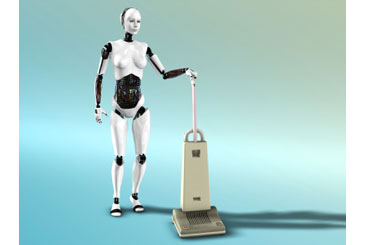|
|
| My Robot Is Better Than Your Robot |
| By Joe Bouchard |
| Published: 07/27/2015 |

The following is an installment in "The Bouchard 101", a series featuring "Ice Breaker's" designed to promote training awareness and capabilities in the corrections industry. For those of us who became adults before the year 2000, the future seemed special. Before it happened, we saw 2000 as the mark of innovations, great advances, and a world made easier by science. But most of us forgot that it is just a round number, made to seem significant by the expectations of others. Looking back, our future was not what we thought it would be. While we have cell phone magic and computer wizardry, we so not have humaniform robots roaming among us undetected. (Or do we, conspiracy theorists?) Still, it is human imagination and necessity that help bring innovative ideas into the realm of reality. And this is a good premise to use to tap the creativity of the minds of corrections staff. “My robot is better than your robot” can be set up in this way: “All of us operate to keep staff, offenders and the public safe. We do so through monitoring, observing, searching and by reading the signs and circumstances. But we are not alone. We do have help from technology. Our security is enhanced by many means: smart fences, metal detectors, urinalyses and surveillance cameras. These technological assistants are with us in our constant battle to keep danger out of our facilities. For this exercise, we split into groups of four. We are charged with the task of designing a perfect helper inside the prison. With this, we are not replacing staff with automation, but creating a robot that assists us in our daily duties. You have 10 minutes to compile a list of attributes - powers, if you will - that you want technology to produce for a robotic helper. What will your robot do?” Part 1 – Compilation This is a simple stage where the teams make a list of what their robot would do in order to enhance security. You may set the number as you wish, though I suggest 10 different talents. If there is trouble in getting the groups going, here is a list of suggestions:
I will insert a note on espionage. While I do not condone cheating, I see its value as a lesson. The facilitator of this exercise may notice that some groups ‘dip’ and spy on others for ideas. This can be permitted and heralded later as a lesson in discretion, trust and betrayal. Of course, in the end all ideas will be permitted to the whole group. Part 2 – Research With all lists displayed, the facilitator will ask if any of the technologies suggested do actually exist in part or in whole. Those currently available, though not necessarily in a robotic format, will be checked off. This shows the plausibility of each suggestion. If there is internet access in the area, two participants can be assigned to search for such technology. If this option is utilized, the Internet researchers can report out to the rest of the class. Part 3 – Testing Most good theories have fundamental flaws. For example, we can learn the security breach in a child-proofed home from the actions of a clever toddler. In other words, let the child safely field test the area. Just through testing, we can push the limits of security. Of course, all of this is speculative, as the corrections robot is not yet in operation. But we benefit in poking holes in the theories, imagining how a system can be circumvented. True, the year 2000 was pretty much like the late 1990’s. The world did not instantly transform into a brave new world of technological wonder. Developments came over time, gradually. And who better to assist in corrections development than corrections professionals? Joe Bouchard is a Librarian employed with the Michigan Department of Corrections and a collaborator with The International Association of Correctional Training Personnel (IACTP). He is also the author of “IACTP’s Corrections Icebreakers: The Bouchard 101, 2014”. The installments in this series include his opinions. The agency for which he works is not in any way responsible for the content or accuracy of this material, and the views are those of the contributor and not necessarily those of the agency. While some material is influenced by other works, all of the icebreakers have been developed by Joe Bouchard. Visit the Joe Bouchard page Other articles by Bouchard: |
MARKETPLACE search vendors | advanced search

IN CASE YOU MISSED IT
|


Comments:
No comments have been posted for this article.
Login to let us know what you think